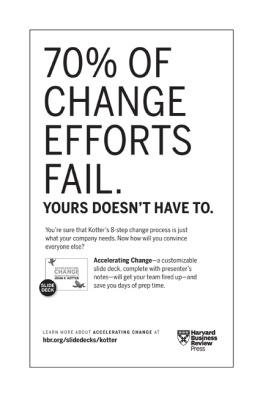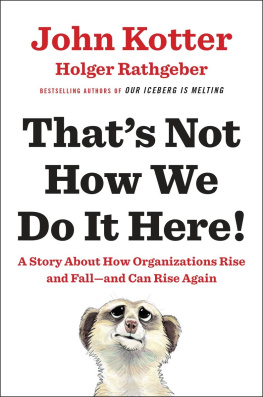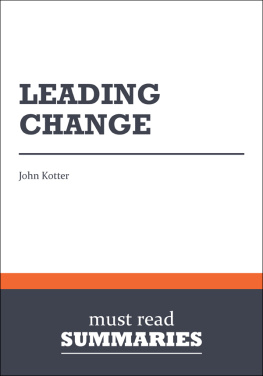Kotter John P. - Leading Change
Here you can read online Kotter John P. - Leading Change full text of the book (entire story) in english for free. Download pdf and epub, get meaning, cover and reviews about this ebook. City: New York, year: 2013;2012, publisher: Harvard Business Review Press;Macmillan Audio, genre: Business. Description of the work, (preface) as well as reviews are available. Best literature library LitArk.com created for fans of good reading and offers a wide selection of genres:
Romance novel
Science fiction
Adventure
Detective
Science
History
Home and family
Prose
Art
Politics
Computer
Non-fiction
Religion
Business
Children
Humor
Choose a favorite category and find really read worthwhile books. Enjoy immersion in the world of imagination, feel the emotions of the characters or learn something new for yourself, make an fascinating discovery.
- Book:Leading Change
- Author:
- Publisher:Harvard Business Review Press;Macmillan Audio
- Genre:
- Year:2013;2012
- City:New York
- Rating:4 / 5
- Favourites:Add to favourites
- Your mark:
- 80
- 1
- 2
- 3
- 4
- 5
Leading Change: summary, description and annotation
We offer to read an annotation, description, summary or preface (depends on what the author of the book "Leading Change" wrote himself). If you haven't found the necessary information about the book — write in the comments, we will try to find it.
Kotter John P.: author's other books
Who wrote Leading Change? Find out the surname, the name of the author of the book and a list of all author's works by series.
Leading Change — read online for free the complete book (whole text) full work
Below is the text of the book, divided by pages. System saving the place of the last page read, allows you to conveniently read the book "Leading Change" online for free, without having to search again every time where you left off. Put a bookmark, and you can go to the page where you finished reading at any time.
Font size:
Interval:
Bookmark:
LEADING CHANGE
LEADING CHANGE
With a New Preface by the Author
JOHN P. KOTTER
HARVARD BUSINESS REVIEW PRESS
Boston, Massachusetts
Copyright 2012 by John P. Kotter
All rights reserved
Library of Congress Cataloging-in-Publication Data
Kotter, John P., 1947
Leading change / John P. Kotter.
p. cm.
Includes new preface by the author.
First published in 1996.
ISBN 978-1-4221-8643-5 (alk. paper)
1. Organizational change. 2. Leadership. 3. Industrial organization. 4. Strategic planning. I. Title.
HD58.8.K65 2012
658.4'06dc23
2012031088
Contents
The material in this book is not only still relevant now, sixteen years after it was published, but I believe it is more relevant, and for one simple reason: the speed of change continues to increase.
We know much more today than we did sixteen years ago. I have already published four additional books that drill deeper into these ideas in various ways. I am working on the fifth now, which takes another leap (not an incremental step) into what success will demand in the twenty-first century. But when people ask me where to start their journey to learn about leadership in a changing world, I always have them start here.
The most fundamental mistakes smart people make when they are trying to make big changes, especially implementing high stakes strategies or initiatives, are mostly still the same today (). That does not mean executives have learned nothing in the past few decades. They have. But the challenges have been growing as fast, or faster, than their skills.
The simple insight that management is not leadership () is better understood today, but not nearly as well as is needed. Management makes a system work. It helps you do what you know how to do. Leadership builds systems or transforms old ones. It takes you into territory that is new and less well known, or even completely unknown to you. This point has huge implications in an ever-faster-moving world.
The problems created by complacency, even a little complacency, and the power of a sense of urgency (), are bigger today than they were a decade ago. I truly believe it is impossible to overstate the severity of the challenges caused by an inadequate or unaligned sense of urgency. And very experienced, very smart people fail herewith consequences that may not be clear for a year or even morewhen needed action is delayed or slows down, and train wrecks (or their equivalent) start to become visible.
We have learned an enormous amount in the past decade about the kinds of structures and capabilities that create a powerful enough basis to launch and sustain a big change. But among the general population of leaders and managers, the basics are still very poorly understood (). Task forces, work-streams, and project management organizations are still the most common vehicles used to drive significant change efforts. These structures can help, but they have tendencies that can lead toward wrong processes, and they simply dont have sufficient power for an extremely difficult set of tasks.
And on it goes from on to the end. The problems described are still with us. Their severity, and the negative consequences they cause, are the same today or worse. Although the increasing speed of change has some profound implications that go beyond this book, the pages that follow are filled with insights and action ideas that can be used everywhere today, and with much success.
If you had told me when I wrote this book that Time magazine would list it as one of the twenty-five most influential business/management books ever written, I most certainly would not have believed you. I saw it simply as the next installment in a series of research projects I was conducting at Harvard. Even today, all the recognition the book has received is a bit hard for me to take in. But objectively, I do see how it describes the path of a very powerful set of trends that go back a half century and will probably continue through my lifetime. These trends demand more agility and change-friendly organizations; more leadership from more people, and not just top management; more strategic sophistication; and, most basically, a much greater capacity to execute bold strategic initiatives rapidly while minimizing the size and number of bumps in the road that slow you down.
Speed of change is the driving force. Leading change competently is the only answer.
John Kotter
Cambridge, Massachusetts
In the summer of 1994, I wrote an article for the Harvard Business Review entitled Leading Change: Why Transformation Efforts Fail. It was based on my analysis of dozens of initiatives over the prior fifteen years to produce significant useful change in organizations via restructuring, reengineering, restrategizing, acquisitions, downsizing, quality programs, and cultural renewal. Even as I was finishing that piece I knew I wanted to write more on the subject, so I began this book shortly thereafter.
Leading Change was published in the MarchApril 1995 issue of HBR. Almost immediately the article jumped to first place among the thousands of reprints sold by the review, an astonishing event in light of the quality of its large reprint base and of the lengthy time normally required to build reprint volume. Improbable events like this are always difficult to explain, but conversations and correspondence with HBR readers suggest that the paper rang two bells loudly. First, managers read the list of mistakes organizations often make when trying to effect real change and said Yes! This is why we have achieved less than we had hoped. Second, readers found the eight-stage change framework compelling. It made sense as a roadmap and helped people talk about transformation, change problems, and change strategies.
Ive tried to build on both of these virtues in writing this book, and to add a few more. Unlike the article, the book has dozens and dozens of examples of what seems to work and what doesnt. In this sense, it is more hands-on and practical. Ive also been more explicit in linking the discussion back to the engine that drives changeleadershipand in showing how a purely managerial mindset inevitably fails, regardless of the quality of people involved. Finally, Ive broadened the time span covered, showing how events over the past century have brought us here and exploring implications for the twenty-first century.
Those familiar with my work will see that this volume integrates and extends a number of ideas originally published in A Force for Change: How Leadership Differs from Management, Corporate Culture and Performance, and The New Rules: How to Succeed in Todays Post-Corporate World. Although this book is a logical extension of my past work in terms of subject matter, it is a departure in terms of form. Unlike my previous books, Leading Change is not filled with footnotes and endnotes. I have neither drawn examples or major ideas from any published source except my own writing nor tried to cite evidence from other sources to bolster my conclusions. In that sense, this work is more personal than any Ive previously published. Im communicating here what Ive seen, heard, and concluded on a set of interrelated topics that appear to be increasingly important.
A number of people have read this book in draft form and offered helpful suggestions. They include Darrell Beck, Mike Beer, Richard Boyatzis, Julie Bradford, Linda Burgess, Gerald Czarnecki, Nancy Dearman, Carol Franco, Alan Frohman, Steve Guengerich, Robert Johnson, Jr., Carl Neu, Jr., Charlie Newton, Barbara Roth, Len Schlesinger, Sam Schwab, Scott Snook, Pat Tod, Gayle Treadwell, Marjorie Williams, and David Windom. A few others have offered much inspiration for the work that underlies this manuscript, especially Ed Schein and Paul Lawrence. My thanks to all.
Next pageFont size:
Interval:
Bookmark:
Similar books «Leading Change»
Look at similar books to Leading Change. We have selected literature similar in name and meaning in the hope of providing readers with more options to find new, interesting, not yet read works.
Discussion, reviews of the book Leading Change and just readers' own opinions. Leave your comments, write what you think about the work, its meaning or the main characters. Specify what exactly you liked and what you didn't like, and why you think so.






